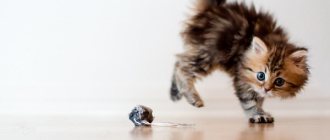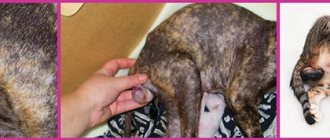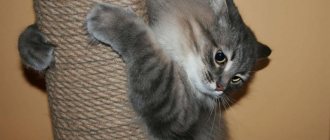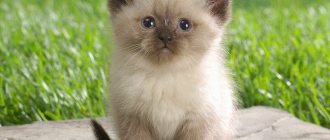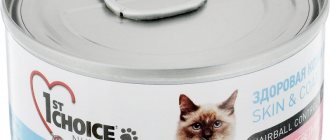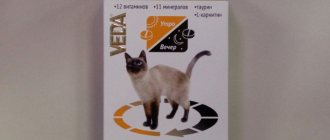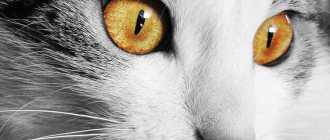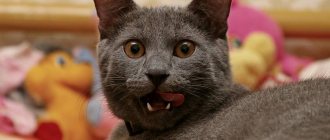Calorie norm
A sufficient amount of calories for a pet is considered to be one that provides the cat with high activity, maintains the required body temperature, and allows the digestive, respiratory and cardiovascular systems to function normally.
The average daily intake of an adult cat is 200-300 J per kilogram of weight. Thus, a pet weighing 3 kg needs about 1000 J daily, cats weighing 4 kg need 14 J, cats weighing 5 kg need 1500 J.
Option 1:
- 25 g beef or veal;
- 5 g lung;
- 10 g water;
- 2 g vegetable oil;
- 5 g yeast;
- 4 g cereal flakes.
Recipe 2:
- 10 g liver;
- 25 g lean fish;
- 4 g buckwheat;
- 7 g water;
- 0.2 g yeast;
- 5 g low-fat cottage cheese.
Symptoms of vitamin deficiency in kittens
Indirect and common signs for all hypovitaminosis that may indicate the disease are:
- weakness;
- lethargy;
- emaciation;
- growth and development delays;
- decreased overall body resistance;
- skin loses elasticity;
- the fur becomes dull.
The diagnosis of “hypovitaminosis” is made comprehensively on the basis of visible clinical signs, comparison of anamnesis data and a laboratory analysis of the animal’s blood for vitamin content.
Nutrition rules
Kitten
From birth to 2 months, kittens are fed mother's milk. Such feedings can be up to 7-8 times a day.
Special milk formulas are purchased at the veterinary pharmacy, which must be fed every 2.5-3 hours, including at night, until the kittens reach 14 days of age. Then once every 3 hours up to 1 month.
During this period, milk is the basis of the diet; there should be no complementary foods. During the second month, babies already need water, and they are also allowed to give food other than milk. Pieces of new food should be small in size, always soaked in milk or meat broth. At 2 months, Scottish cats continue to drink milk. The number of feedings is maintained up to 7 times a day.
At 3 months, the mother's lactation stops. The number of feedings is still high and reaches 6 times a day. The food should be semi-liquid, milk can be given. From 4 to 9 months, gradually reduce feedings to 4 times. Give more and more solid food, gradually increasing the density.
At this age, it is also important to follow the dosage specified by the manufacturer, as well as choose food according to age
Cottage cheese should not be given more than once a week, as it contains excessive amounts of calcium and is likely to straighten the ears of Scottish Folds. But give other fermented milk products more often, about 3 times a week. From the age of 10 months, you can switch your cat to an adult diet 2-3 times a day. On a natural diet, give milk, cottage cheese is allowed more often from now on.
The basis of the diet is meat, it is necessary to give porridge and vegetables. Be sure to give herbs fresh, in the form of a finely chopped supplement. When feeding dry food, choose the right manufacturer. This should not be a mass market; it is advisable to purchase premium feed. Divide the daily dose by 2-3 times, pour into a bowl before meals. Provide constant access to fresh water.
Adult cats
The rules for feeding cats older than one year on a natural diet include several points.
- Meat should be present in the diet every day, at every meal. Choose low-fat varieties: chicken, rabbit, beef.
- Fish is needed in the diet 2 times a week. Marine representatives with low fat content of meat are desirable.
- Give porridge about 3-4 times a week. It can be buckwheat, barley, wheat.
- Dairy products.
- Vegetables should also be on your pet's menu. The multiplicity in the diet is the same as for cereals.
- Fruits can be given in small quantities, preferably in the first half of the day. Choose unsweetened fruits: apples, pears. Very rarely allow your pet to indulge in grapes.
- Provide fresh grass daily. To do this, you can germinate wheat and green buckwheat yourself. You can also purchase special herbs in pharmacies.
- Cats on natural food need supplements in the form of vitamins and minerals once every 6-12 months.
- It is forbidden to give cats food from your table, as well as pamper them with baked goods and confectionery.
You will not have any difficulties when feeding dry food. Manufacturers have fully taken into account the pet’s needs for nutrients, vitamins, minerals, and herbal supplements. You will only need to follow the dosage indicated on the pack.
The most important thing on artificial food is constant access to fresh water. Since there must be a lot of it to digest crackers
Sterilization
After a year, you need to decide whether you will castrate the kitten or not. If you have decided to sterilize, you first need to switch the cat to special food and only then send the animal for surgery. With natural feeding, you will simply need to reduce the portion size and the overall fat content of the diet for a sterilized cat.
Vitamins for cats - difference from vitamins for kittens
They differ in different composition. Kittens need more trace elements, especially taurine and L-carnitine, as kittens grow, develop, and strengthen their bones.
And adult cats need vitamins during molting (spring and autumn), during pregnancy, after childbirth, after injuries, and in old age.
During pregnancy, a cat lacks microelements, since she gives all the vitamins to her baby. Therefore, in addition to a balanced diet, the mother cat needs to be given multivitamins containing calcium, trace elements and amino acids and essential fatty acids in balanced quantities.
After giving birth, a cat may suffer from brittle bones and heavy shedding, so it is necessary to give wool vitamins with biotin, which promotes the formation of a thick coat and strengthening the claws (multivitamins with biotin should also be given during shedding - in autumn and spring).
If you give a castrated cat special food enriched with proteins, L-carnitine and a reduced dose of starch, then your pet will not gain excess weight and the risk of developing diabetes will be reduced.
Vitamins for cats are also needed in old age - to improve the genitourinary systems (Nutri-Vet Uri-Ease 2 times a day, 1 capsule per 5 kg of your pet’s weight) and Nutri-Vet Hip & Joint Plus Paw-Gel to improve the functioning of muscle ligaments and joints.
And finally, a video about such charming babies.
We recommend that you read: Detailed video answer to the question “At what age can a kitten be given vitamins”:
Feeding spayed and neutered animals
The nutrition of sterilized cats and neutered cats has its own specifics. So, for the first 12 hours the cat recovers from anesthesia - at this moment there is no need to offer food, as soon as the animal begins to feel better, you should give it something to drink through a syringe, making sure that the pet does not choke.
Usually, on the first day, Scots refuse to eat; you should not force them to eat.
On the second day, the animal is offered about a third of the usual portion; this is important so that the animal does not strain during defecation.
After 3 days, the Scots regain their appetite and begin to show interest in food - from this moment you can begin to gradually increase the amount of food, bringing it up to 150 g per day.
From time to time, give your furry a check: once a month, run your hands along his sides - if you feel the ribs, then you have nothing to worry about, and if the cat has gained too much weight, then you should temporarily exclude cereals from his diet, focusing on meat, vegetable and fish products.
If you feed your pet with ready-made formulas, then it is worth purchasing specialized formulations “for castrated and sterilized animals.”
How to feed pregnant and lactating cats?
Compiling an optimal diet for expectant and nursing mothers deserves special attention. During this period, animals need much more food and the proteins, vitamins and minerals that come with it.
That is why the quality of feeding at such a moment is extremely important. However, increased portion sizes should be avoided, since a pregnant cat’s stomach does not enlarge and, therefore, does not acquire the ability to digest large volumes of food.
When organizing the diet of a pregnant Scottish cat, you should follow several rules.
It is forbidden to give fish
It is better to include liver (chicken or beef) in the menu. It is important to provide your cat with food containing calcium. This is cheese, low-fat cottage cheese or fermented baked milk
The drug “Kaltsex” should be added to the feed, as well as meat and bone meal. It is very important to provide your pregnant cat with constant access to clean water, especially if she is fed dry food mixtures. You can’t suddenly change the animal’s diet. If before pregnancy the cat was fed ready-made food, then you should not change it to “natural” food - a sudden change in the type of food will not benefit the pet.
However, you can transfer your Scottish cat to a specialized composition for pregnant and lactating cats from the same manufacturer to which she is accustomed. It usually contains more calories, vitamins and other nutrients to ensure kittens develop fully in the womb and keep the mother healthy and alert. Thus, while receiving the same amount of food, the animal will have much more strength and energy to bear healthy kittens.
A couple of weeks before giving birth, the amount of food is reduced by about a quarter - this is important so that the kittens do not gain too much weight. Otherwise, there is a risk of complications during childbirth
A few days before giving birth, the cat begins to refuse food offered. There is no need to worry - this is a completely normal phenomenon, do not force her to eat, just provide peace and prepare everything necessary for the birth of the babies.
After childbirth, a young mother also often lacks appetite. Usually the reason for this is that she eats her placenta - don't let her eat more than three as this can cause diarrhea.
During lactation, the animal's appetite increases sharply, since it needs to provide vital energy not only for itself, but also for its children. When forming a cat’s diet at this moment, you need to take into account the weight of the kittens and their number in the litter.
As the kittens transition to solid food, the cat will often eat the same foods that are offered to her kittens - this happens on an instinctive level, since consuming the same food makes the milk more easily digestible for the kittens.
As a rule, during breastfeeding, a Scottish woman loses a lot of weight and quickly returns to the shape she had before pregnancy. Be sure to make sure she doesn't become exhausted. If you notice that the weight of a young mother is below normal, then you should offer more high-calorie food or use ready-made food for kittens.
Depending on the breed
When choosing food for animals, it is important to take into account their breed.
British
British Fold kittens have large bones, which requires increased calcium intake during the formation of a strong skeleton at a young age.
Scottish
For Scottish Folds, on the contrary, it is better to limit calcium for the correct development of the shape of the ears, which in this breed should be naturally soft.
Maine Coons
Special vitamins are required for Maine Coon kittens from 2 months of life and throughout the period of active growth. Adult Maine Coons need 2 times less calcium than small pets.
For Maine Coons, the best Top 10 complexes from Beaphar or Canivita from Canina are suitable. For the formation of joints and bones, phosphorus and calcium contained in Petvital GAG from Canina or Calcidee from 8in1 are important for Maine Coons. For Maine Coon coat health, vitamins for kittens from Canina CAT FELL OK and BREWERS from 8in1 are suitable.
General feeding rules
- Breed name: Scottish Fold cat (Scottish Fold).
- Country of origin: Scotland / UK.
- Weight: 4–5 kg.
- Height at withers: up to 30 cm.
- Average life expectancy: up to 15 years.
- Average price: 5–20 thousand rubles.
At the very beginning of their lives, Scottish cat babies feed exclusively on their mother's milk, so feeding such a pet does not cause problems. This period lasts several weeks, after which any breed of cat, including the Scottish Fold, can be fed one of three main types of food:
- exclusively natural and fresh food products;
- dry or jelly-like ready-made food;
- proper mixed diet.
As a replacement for mother's cat's milk, special adapted formulations can be used, as well as some self-prepared mixtures based on:
- 250 ml of concentrated milk, half an egg yolk and a couple of teaspoons of fructose;
- 100 ml cow's whole milk, 30 g whole milk powder and 5.0 g dry yeast;
- 100-110 ml of whole milk, 100-110 g of boiled milk, raw egg yolk and a couple of teaspoons of corn oil.
When choosing a feeding method, it is necessary to take into account the taste preferences of your pet, and also focus on the availability of a sufficient amount of free time required for independent cooking. A kitten aged one and a half to two months should be fed five times a day.
It is also permissible to provide such a pet with free access to food. By about six months, the number of feedings is gradually reduced to three times a day, and starting from eight months, the kitten is transferred to two meals a day. The food given to your pet must be fresh and at a comfortable room temperature. Among other things, the kitten should have access to clean drinking water at all times.
- The basis of the menu should be meat. Natural food or ready-made food: pay close attention to the composition and quality of raw materials.
- Artificial additives, dyes, spices, salt, stabilizers, flavors and sugar are prohibited. By excluding them, you will ensure the natural development and good health of your pet.
- Provide the Scot with water. This is the most important feeding rule.
- Make sure the food is at room temperature and the correct consistency. It is better to give crushed food to Scottish kittens up to 3 months old. Closer to 6 months, they switch to large pieces, which will ensure normal development of the jaw muscles.
The Scots, together with the British, have long dictated the rules of home etiquette. Not only its health depends on how carefully you pay attention to feeding a kitten, and then an adult cat. A satisfied pet who is satisfied with the contents of the bowl will become a source of peace and well-being in your family.
Advantages of ready-made feeds
Why are more and more owners of kittens switching to ready-made food? Perhaps the secret is that everyone wants to have a kitten, but there is simply no one to care for and feed it. Constantly being busy at work means that owners have no time to boil meat, fish, or grind food to remove bones.
Ready-made food has many advantages. Premium mixtures are designed for feeding cats, taking into account their age, body type, belonging to a specific breed, and are even available for neutered and lactating pets.
Popular foods that are suitable for Scottish babies:
- Wahre Liebe "Junge", produced in Germany. The food contains colostrum, so the product is well absorbed and can be used for feeding from the earliest months. In addition, the food contains chicken and turkey meat, as well as rice, egg and beet pieces. The manufacturer assures that the food can be used to prevent urolithiasis.
- Fans of the fish menu will appreciate Hill's Science Plan Kitten Tuna - dry food, made in the USA. It contains: floured tuna meat, chicken, animal fat, flaxseed, corn, beets, fish oil, Omega-3 and Omega-6 acids. Kittens really like the food. Long-term use helps strengthen the immune system.
- Canadian manufacturers offer high protein dry food 1st Choice Kitten. It contains, in addition to chicken and herring meat, rice, barley, oatmeal, egg powder, tomato and beets. The food is hypoallergenic, therefore suitable for pets suffering from food allergies.
- Another dry food from French manufacturers is Royal Canin British Shorthair Kitten, containing dried poultry meat, extract from cartilage and crustacean shells, fish oil, corn, and chopped beets. According to the annotation, the food is a preventative against joint pathologies.
- For lovers of wet food, the French offer Royal Canin Kitten Instinctive. In addition to meat and meat products, it contains cereals, yeast and milk.
- The manufacturer Purina Pro offers Plan Dental Plus food for small kittens. The unique composition allows you to maintain your pet’s oral cavity in excellent condition. The food prevents the formation of dental plaque.
- Hills high carbohydrate food is designed for active kittens. It contains calcium and magnesium, which the baby needs for full development. The food is not suitable for overweight kittens.
The calorie content and consumption rate must be indicated on food packages, so you must follow the manufacturer’s recommendations. The average norm for a Scottish kitten is 200 kcal.
Ready-made food is divided into the following types:
- dry;
- wet;
- semi-moist.
When choosing dry food, you need to remember about constant access to a drinking bowl, otherwise the cat will have problems with bowel movements.
Dry and wet formulations from the same manufacturer are allowed to be used for mixed feeding. At the same time, they are not combined into one feeding, but distributed alternately:
- one feeding – dry portion;
- second feeding - wet canned food.
Dry food must be stored properly
Before purchasing a package of food, you should pay attention to the following points:
expiration date and storage conditions; manufacturer's brand and type of food (it is best to choose a premium and holistic line); the age of the pet indicated on the packaging and actual age; special additives. The food may contain increased amounts of certain microelements and vitamins. Feeds are not only balanced, but also medicinal
Not all kittens need special food, so you should pay close attention to the instructions on the food.
Breed Features
The Scottish Fold, or Scottish Fold, is a naturally occurring breed. A cat with curled ears was born in Scotland and gave similar offspring. Then breeders began breeding the breed. Now folds can be found everywhere.
Adult Scottish Folds are medium sized, strong built, with thick, soft fur. It can be of different colors: plain, with a pattern or white splashes.
Scottish Folds are friendly, unpretentious in feeding and care, and very attractive in appearance. These qualities allowed the Scots to fall in love and spread along with British cats.
Features of the breed that determine the principles of feeding:
- Fold-eared Scots appeared naturally, in natural conditions. This influenced the preservation of predatory instincts among modern Scots. Therefore, the basis of the diet should be meat products.
- Formation of the jaw and replacement of teeth. This process occurs during the first 6 months of life. Oral hygiene comes to the fore. During this period, food should be soft so that the kitten can chew it comfortably. If feeding occurs incorrectly, the following symptoms will be detected: salivation, unpleasant odor, yellowing of the enamel, formation of tartar, swelling of the gums.
- Tendency to obesity. Scottish Folds can quickly gain weight if they are overfed. Therefore, it is important to follow the feeding regime and not exceed the daily calorie intake. At an early age, this is not a threat, since kittens are very active and playful, so calories will be spent on replenishing energy, growth and development.
- Susceptibility to diseases: constipation, bladder stones, heart pathologies. This leads to the fact that the diet must be balanced in nutrients and nutrients. It is important to pay attention to prohibited products.
- Late development. Scots, unlike wild breeds, develop more slowly, which affects the first feeding. The optimal period for introducing solid food is 1 month.
- The importance of diet choices. The psychological characteristics and health and appearance of an adult animal depend on the first feeding. Thus, with the introduction of meat products, kittens will learn hunting skills earlier and develop dexterity.
Nutrition is an important condition for the normal growth and development of Scottish Fold kittens. It must be balanced, designed for the needs of a growing organism. When feeding, it is important to take into account breed characteristics in order to avoid health problems for your pet.
Why are they needed?
Vitamins have a beneficial effect:
- Increases the immunity of animals.
- Improve physiological processes.
- Help your pet cope with problems with illness.
The intake of retinol is necessary for the pet for normal growth. Of particular importance for the development of a kitten is calciferol, which is involved in the formation of the skeleton and has a positive effect on the metabolism of phosphorus and calcium in the animal.
The intake of tocopherol into the pet’s body ensures the correct formation of the reproductive system.
Ascorbic acid is needed by a growing animal for the absorption of sugar from the intestinal tract, cellular respiration, and the prevention of pathologies in the walls of the capillary vessels of the kitten. Kittens need additional vitamins during illness to support a weakened body.
How does vitamin deficiency manifest in a kitten?
If a kitten has already begun to develop a deficiency of vitamins in the body, then clear symptoms of health problems appear. The fact that your pet’s diet needs to be enriched with vitamins is evidenced by the following changes in its condition :
- apathy,
- weight loss,
- general weakness,
- decreased immunity,
- noticeable growth retardation,
- decreased skin elasticity,
- dull looking coat
- baldness.
If your pet has at least one sign of vitamin deficiency, you should urgently show it to a veterinarian and then treat it with a vitamin complex, which will be prescribed by a specialist.
To accurately determine which vitamin is missing in the animal’s body, a blood test is performed. Based on its results, complex vitamin preparations or only one specific vitamin, the deficiency of which has arisen, are prescribed.
© shutterstock
Dry food review
Dry food is recognized as one of the most popular and in demand food products for cats. The granules of such food remain fresh for a long time; they do not need to be pre-cooked before serving to the cat. Dry foods are very convenient for owners. True, they are not suitable for animals of all ages.
Some cats prefer not to chew dry food, but to eat the whole granules. As a result, this behavior can lead to not the best consequences:
- overeating - until the granules have time to gain volume and moisture, the cat will not feel full with food, even if the portion for him is chosen correctly;
- bloating of the cat's abdomen;
- constipation, which often occurs due to dehydration.
When choosing dry cat food, you must take into account a number of features.
Dry food for cats and kittens must be chosen based on the class. It is not recommended to buy budget options in the economy category. They can be given to fluffies, but very rarely, as an exception. Often animals should not eat them - this can negatively affect their health. Premium and super-premium food is more suitable.
Thus, one of the highest quality dry food is Canadian-made products from the 1st Choice brand. This food is ideal for the Scots. It is balanced and has an optimal ratio of fats and proteins. The main advantages of this food are the following:
- economical consumption;
- cats feel full even from small portions;
- can be used for a regular diet;
- contains all the necessary minerals and vitamins;
- does not cause allergies;
- It's not too expensive.
NOW Natural Holistic is another high-quality, well-formulated dry food. This food should be given to Scottish breed kittens as it is designed specifically for them. To produce feed, we use natural meat from birds and other animals raised on Canadian farms. The main advantages of good food from this manufacturer are:
- ideal ratio of fats and proteins;
- no soy, gluten, growth hormones or meat flour in the composition;
- Can be eaten even by pregnant or lactating cats.
There are no serious disadvantages to such foods, but you need to be prepared for the fact that they are not very cheap.
High-quality dry food from Acana is very popular among owners. They do not contain vegetable protein, but have a large percentage of natural ingredients. If you give your Scottish cat this food, you will not have to additionally feed it with various vitamin supplements. As in the other cases mentioned above, the ratio of fats and proteins in this diet is optimal.
The main advantages of these feeds are:
- the presence of a large number of natural ingredients, for example, fish or poultry meat;
- use of fresh and whole fillets in production;
- can be used as a staple diet.
Acana food is of excellent quality, but is a bit expensive.
Almo Nature offers consumers a choice of high-quality Italian food for cats and kittens. They include a large percentage of meat and fish. Due to this, the Scottish cat will receive all the components it needs. At the same time, excess weight will not be a problem for your pet if he eats such dry food. That is why very often such products are purchased for neutered cats.
Here are the advantages of this product:
- composition rich in vitamins and minerals;
- absence of dyes, preservatives, flavors and various additives;
- does not cause allergic reactions;
- has a balanced composition;
- has a reasonable price.
No serious deficiencies have been identified in these feeds.
There are also simpler dry food that are several times cheaper. For example, Whiskas products are well known to everyone due to advertising. This food belongs to the economy category. It is not recommended to give it to cats on a regular basis - such food is completely unsuitable for the daily diet. Of course, these foods are cheap and are sold in many stores, but their composition leaves much to be desired. There are dyes of unknown origin, as well as preservatives and antioxidants, information about which cannot be found either.
Dry food from another well-known brand, Kitekat, has similar features. Their composition also cannot be called good, suitable for representatives of the Scottish breed. You shouldn’t skimp on your pets’ health by offering them such cheap food.
What to do if the kitten does not want to eat vitamins
A cat is a picky animal and may refuse vitamins or food if something in it does not suit her. In this case, you should contact a specialist and analyze the problem that has arisen - after all, the reason may lie in small things:
- if you don’t like the taste, you need to replace it with another drug with a different taste;
- I don’t like the shape - cats often refuse to swallow the tablets. In this case, you can choose a gel or powder and mix them into food, or grind existing tablets into powder and also add to food.
Choosing vitamins is a responsible matter. It is worth remembering that high-quality drugs cannot be cheap, they are not sold on the market by weight - there is no need to save money if you decide to include supplements in your diet. And be sure to consult a veterinarian - only a competent specialist will correctly select the necessary complex, taking into account the developmental characteristics and condition of the kitten.>Vitamins for cats with calcium - a review of drugs with instructions, composition, indications and prices
Nutritional features of small kittens
Until the kitten reaches the age of 1 month, it is fed by its mother, usually for the first 2 weeks the number of feedings reaches 10 times a day, and by the month there are already 8 of them, including at night.
If for some reason there is no mother, or she cannot feed the cubs, then the owner must take all care of the newborn.
In the first 2 weeks, feeding should be done every 2 hours at the rate of 30 ml per 100 g of the baby’s body weight, from 2 to 4 weeks the feeding volume should be 50 ml per 100 g of body weight and after a month - about 55 g.
The product is administered using a syringe or a special pipette
The mixture is poured very carefully so that the baby does not choke. Cow's milk is not suitable for kittens
The fact is that cat milk consists of 70% water, it contains 11% proteins and 3% lactose, and the fat content does not exceed 11%.
Cow's milk contains about 89% water, 3.2% protein, 3.2% fat and 5.3% lactose. Despite the similarity of composition, the volume of proteins in cow's milk is much lower, but the amount of lactose, on the contrary, much exceeds the proportion of the component in cat's milk. And any veterinarian will confirm that a small kitten’s body digests large amounts of lactose with great difficulty.
A one-month-old kitten begins to introduce solid food into its diet. However, the concept of “solid” in this case is relative. At first, it is crushed and diluted to a mushy state, and the more liquid the mash, the better for the young Scot.
Sometimes breeders are forced to introduce complementary foods up to 1 month - this happens if the cat is exhausted and has very little milk - then the kittens begin to squeak frequently and try to cling to the cat's chest and fingers of their owners.
They start complementary feeding with one type of food, and only after the kitten has digested it, they offer the next one. It is best if fermented milk products are used as the first food additive - for example, low-fat cottage cheese or fermented baked milk.
At 2 months, the Scot’s body is already ready for weaning, but not abruptly - the transition to solid food should come slowly, which is why breeders rarely sell kittens under three months. At this time, the kitten eats approximately 6 times a day, and the total amount of food consumed is about 180 g per day.
By the end of the second month, you can offer your pet small pieces of meat - by this time his teeth have already formed. It will be better if you mix the meat with grated vegetables or soaked bran.
At 2 months he is vaccinated against distemper and rhinotracheitis, and at 3 months he is revaccinated.
At 3-4 months, the kitten begins to actively grow, and its gastrointestinal tract is finally formed. During this period, it would be useful to introduce vitamin and mineral complexes into the diet, which must contain calcium.
From 4.5 months, the kitten is already considered a teenager and continues to grow, so it requires protein-rich food. Meat best meets his protein needs. In this case, there is no longer any need to grind the product; it can be served cut into medium-sized pieces; the animal at this stage of its life must certainly train its jaws.
From 5 months, you can introduce low-fat fish into the diet, it is advisable to take sea fish - this product is offered to cats exclusively in boiled form and no more than once a week.
From 9 months, a kitten is already considered an adult, although the Scots form until two years old, nevertheless, the animal’s need for proteins and calories is already the same as that of older pets - 2-3 feedings per day are enough for him, the total amount of food is usually 180 -200 g.
The little Scotsman should have his own bowls and constant access to water. The water should be changed daily and the drinking bowl should be kept perfectly clean. By the way, cats really love running water, so they like all kinds of “fountains”.
Breeders all over the world have been arguing for many years about what is healthier for a small pet – natural or factory-made food. It is impossible to give a definite answer to this question, since much depends on the owner’s ability to create a balanced menu for his pet at home, because nothing better than natural food has yet been invented.
But if you do not have the necessary time, then it is better to opt for food that contains all the necessary micro- and macroelements, but keep in mind that preference should be given to premium and super-premium formulations, always marked “for kittens”.
Why and what vitamins and amino acids do your pet need?
Vitamins for cats contain different combinations of nutrients, depending on their intended purpose.
After all, the body of a small kitten, a nursing cat or an elderly neutered cat requires an individual approach. For one, it would be good to generally strengthen the immune system, for example, after an illness. Another option is to buy a vitamin-mineral complex designed specifically for skin and coat. Typically, a cat's diet is supplemented with mineral compounds and amino acids, the deficiency of which cannot be compensated for by food, even with the most varied feeding.
Vitamins of different groups have strong antioxidant activity, affect metabolic processes and significantly strengthen the immune system.
Among the most important vitamins for cats are:
- A. Prevents problems with the immune system and eyes.
- Group B. The most important vitamins. They have an overall impact on the cat’s life. Important for the normal functioning of the nervous system, gastrointestinal tract, musculoskeletal system and the formation of muscle tissue. The deficiency affects the genitourinary system, skin and wool, and is fraught with problems with the eyes and mucous membranes. Mandatory for the normal functioning of the heart and blood vessels.
- C. A stimulator of the immune system, without which not a single process can do. In addition to providing protective functions, it promotes the absorption of mineral compounds and is actively involved in metabolism.
- D. It is unlikely that molting or changing teeth will be possible without vitamin D. It is important in the formation and development of all tissues and promotes the absorption of calcium. Especially important for kittens.
- E. Multifunctional nutrient, significantly affects the reproductive system. Without the participation of this vitamin, cats are not able to reproduce.
- K. Participates in hematopoiesis. The normal coagulation pattern depends on it. If there is a deficiency, the slightest damage to the skin can lead to death.
The list is not exhaustive. The role of other vitamins should not be underestimated. In total there are about 13 groups of vital compounds.
It is important to remember that vitamins only in combination with minerals and amino acids guarantee a cat’s health. The list of micro- and macroelements in most complexes has a standard composition
Amino acids require special attention. Of the 23 groups of these substances, 11 are not synthesized in the cat’s body, which leads to irreversible consequences. Amino acids are involved in feline metabolism and metabolism. Without them, the normal functioning of any system is impossible. In particular:
- taurine;
- arginine;
- isoleucine;
- lysine;
- threonine;
- tryptophan;
- methionine;
- leucine;
- phenylalanine;
- valine;
- histidine
At the pet store
Vitamins for kittens are divided into two groups:
- natural (made from natural raw materials) – Gimpet, Canina, Hartz;
- synthetic (made from artificial substitutes) - Nutri Vet, 8in1, Vitakraft, Sanal, Biofactory.
If kittens do not feed on mother's milk or there are developmental abnormalities in the animal, it is necessary to give vitamins that are selected according to age. The best products can be purchased at a pet store.
After reaching 1.5 months, it is necessary to give animals vitamins for kittens with calcium and phosphorus. Doctor Zoo vitamins intended for kittens from 3 months will be useful. Doctor Zoo is compatible with any diet - dry food, natural products. Taking the Doctor Zoo multivitamin complex improves metabolism, normalizes the activity of all organs and systems, increases the animal’s immunity and coordination of movements.
A popular product is Beafar, produced in the form of tasty treats for animals from 1.5 months of life and containing all the useful substances necessary for proper development. Beophar contains sodium, biotin, calcium, phosphorus and potassium. It is recommended to take Beafar daily, 1-4 tablets per 1 kg of animal weight. Your veterinarian will help determine the exact dosage of the product.
Vitamins for immunity
General strengthening complexes are great for boosting immunity, but additional components of specially developed vitamin products will help increase the cat’s body’s resistance to many diseases.
Good preparations are made on the basis of antioxidants, essential amino acids, adaptogens and a variety of micro- and macroelements.
Before offering such remedies to your cat on the advice of a veterinarian, it is important to make sure that the animal does not have parasites:
- Gimpet Topinis;
- VetoMune VetExpert;
- Anivital Feli Immun;
- Canina Petvital Energy-Gel or Petvital Bio-Activator.

